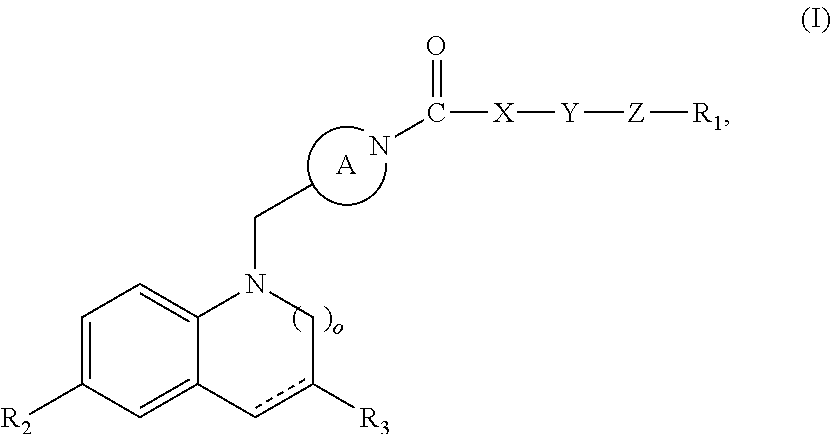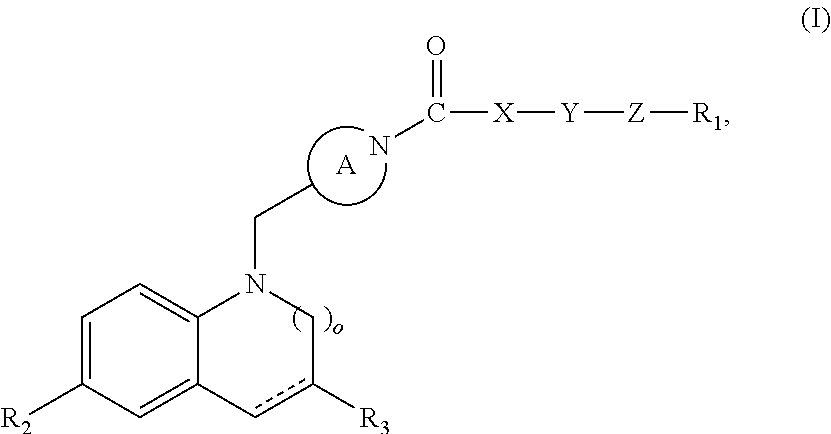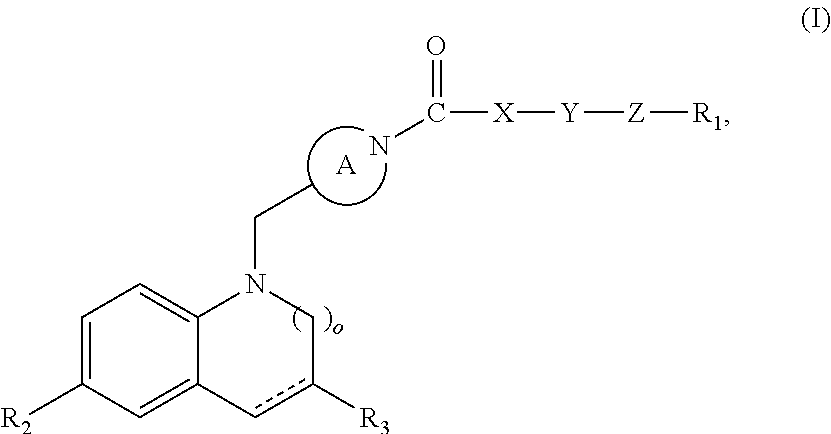Retinoic acid receptor-related orphan receptor modulators and uses thereof
a technology of orphan receptor and retinoic acid, which is applied in the field of retinoic acid receptor related orphan receptor (ror) regulated diseases and disorders, can solve problems such as relative imbalan
- Summary
- Abstract
- Description
- Claims
- Application Information
AI Technical Summary
Benefits of technology
Problems solved by technology
Method used
Image
Examples
example 1
Synthesis of 1-(pyrrolidin-3-ylmethyl)-5-(1-(tetrahydro-2H-pyran-2-yl)-1H-pyrazol-4-yl)-1H-indole
[0270]
Reaction step 1. Synthesis of benzyl 3-(tosyloxymethyl)pyrrolidine-1-carboxylate
[0271]To a solution of benzyl 3-(hydroxymethyl)pyrrolidine-1-carboxylate (7.50 g, 31.9 mmol) and triethylamine (13 mL, 96 mmol, 3.0 eq) in dichloromethane (70 mL) was added TsCl (9.12 g, 47.8 mmol, 1.5 eq) slowly at 0° C. The mixture was allowed to warm to room temperature and stir overnight. After completion of the reaction (monitored by TLC, 50% ethyl acetate-hexane Rf=0.6), the mixture was poured into cool water and washed with water followed by brine. The organic layer was dried over anhydrous sodium sulfate and solvent was removed under reduced pressure. The crude product was purified by column chromatography over neutral alumina, eluting with a 0-12% gradient of ethyl acetate in hexanes to afford benzyl 3-(tosyloxymethyl)pyrrolidine-1-carboxylate (8.16 g, 68%) as colourless oil. LCMS m / z=390 (M+1)...
example 2
Synthesis of phenyl(3-((5-(1-(tetrahydro-2H-pyran-2-yl)-1H-pyrazol-4-yl)-1H-indol-1-yl)methyl)pyrrolidin-1-yl)methanone
[0275]
[0276]To a solution of 1-(pyrrolidin-3-ylmethyl)-5-(1-(tetrahydro-2H-pyran-2-yl)-1H-pyrazol-4-yl)-1H-indole (0.100 g, 0.285 mmol, 1 eq) in dichloromethane (5 mL) and triethylamine (194 L, 1.43 mmol, 5 eq) was added benzoyl chloride (40 μL, 0.34 mmol, 1.2 eq) at 0° C. The reaction mixture was allowed to stir at room temperature for 3 h. After completion of reaction (monitored by TLC, 5% MeOH-dichloromethane Rf=0.4), the reaction was quenched by addition of saturated NaHCO3 solution, and the mixture was extracted with dichloromethane. The combined dichloromethane layers were washed with water followed by brine. The organic layer was dried over anhydrous sodium sulfate and solvent was removed under reduced pressure. The crude product was purified by column chromatography over neutral alumina, eluting with a 0-60% gradient of ethyl acetate in hexanes to afford phe...
examples 3-8
[0277]Using the procedure described in Example 2, starting with 1-(pyrrolidin-3-ylmethyl)-5-(1-(tetrahydro-2H-pyran-2-yl)-1H-pyrazol-4-yl)-1H-indole and the acid chloride indicated, the intermediates shown in table were prepared.
StartingLCMSacidYieldm / z / ExamplechlorideProduct(%)purity32-phenyl-1-(3-((5-(1-(tetrahydro-2H-pyran- 2-yl)-1H-pyrazol-4-yl)-1H-indol-1- yl)methyl)pyrrolidin-1-yl)ethanone61%Tr = 2.15, m / e: 469.23 (M + 1) / 95.4%43-phenyl-1-(3-((5-(1-(tetrahydro-2H-pyran- 2-yl)-1H-pyrazol-4-yl)-1H-indol-1- yl)methyl)pyrrolidin-1-yl)propan-1-one38%Tr = 2.21, m / e: 483.23 (M + 1) / 90.2%5cyclohexyl(3-((5-(1-(tetrahydro-2H-pyran-2- yl)-1H-pyrazol-4-yl)-1H-indol-1- yl)methyl)pyrrolidin-1-yl)methanone37%Tr = 2.24, m / e: 461.24 (M + 1) / 89.4%62-cyclohexyl-1-(3-((5-(1-(tetrahydro-2H- pyran-2-yl)-1H-pyrazol-4-yl)-1H-indol-1- yl)methyl)pyrrolidin-1-yl)ethanone63%Tr = 2.32, m / e: 475.28 (M + 1)73-methyl-1-(3-((5-(1-(tetrahydro-2H-pyran- 2-yl)-1H-pyrazol-4-yl)-1H-indol-1- yl)methyl)pyrrolidin...
PUM
| Property | Measurement | Unit |
|---|---|---|
| temperature | aaaaa | aaaaa |
| temperature | aaaaa | aaaaa |
| Time | aaaaa | aaaaa |
Abstract
Description
Claims
Application Information
 Login to View More
Login to View More - R&D
- Intellectual Property
- Life Sciences
- Materials
- Tech Scout
- Unparalleled Data Quality
- Higher Quality Content
- 60% Fewer Hallucinations
Browse by: Latest US Patents, China's latest patents, Technical Efficacy Thesaurus, Application Domain, Technology Topic, Popular Technical Reports.
© 2025 PatSnap. All rights reserved.Legal|Privacy policy|Modern Slavery Act Transparency Statement|Sitemap|About US| Contact US: help@patsnap.com



